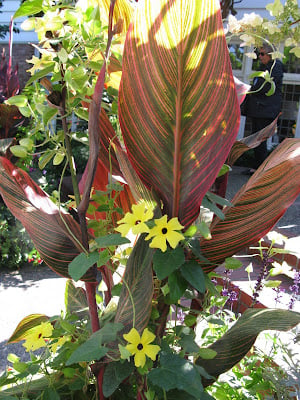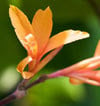Cannas in the Garden
If you read this blog on a regular basis, you may be aware of my fondness for canna lilies. If you read this blog on a regular basis, you may be aware of my fondness for canna lilies. This winter I am overwintering eight large trash bags filled with canna roots. Friends are starting to place their requests for planting-size chunks this spring!
 I wasn’t always a canna fan and I still don’t like the full-size flowers very much. My friend and fellow blogger David Grist got me started with two of the smaller-flowered varieties. Intrigue has delicate, bright orange flowers that create a bold contrast with the dusky, purple-burgundy-blue-green foliage. In the slideshow at the end of the post, you can see it in the picture of my cutting garden, planted with amaranth. I also grow Panache, which has long slender buds that open into spidery, pale-peach flowers with hints of yellow and pink. Its foliage is plain green, but the leaves are slightly frosty with a blueish tint. Hummingbirds love both of them.
I wasn’t always a canna fan and I still don’t like the full-size flowers very much. My friend and fellow blogger David Grist got me started with two of the smaller-flowered varieties. Intrigue has delicate, bright orange flowers that create a bold contrast with the dusky, purple-burgundy-blue-green foliage. In the slideshow at the end of the post, you can see it in the picture of my cutting garden, planted with amaranth. I also grow Panache, which has long slender buds that open into spidery, pale-peach flowers with hints of yellow and pink. Its foliage is plain green, but the leaves are slightly frosty with a blueish tint. Hummingbirds love both of them.
 There are lots of ways to use cannas in the garden. I especially like growing them in large pots. You need to be prepared to water heavily almost every day and fertilize generously, but they’ll reward you handsomely with big, tropical foliage and soaring flower spikes. Make sure you pick a very large, heavy-duty pot (the size of a half whiskey barrel leaves room for some companion plants). From personal experience, I recommend using a pot that doesn’t taper inward at the top. By the end of the growing season, the entire pot will be completely filled with canna roots and if the pot is narrower at the top than the bottom, it will be virtually impossible to remove the root ball.
There are lots of ways to use cannas in the garden. I especially like growing them in large pots. You need to be prepared to water heavily almost every day and fertilize generously, but they’ll reward you handsomely with big, tropical foliage and soaring flower spikes. Make sure you pick a very large, heavy-duty pot (the size of a half whiskey barrel leaves room for some companion plants). From personal experience, I recommend using a pot that doesn’t taper inward at the top. By the end of the growing season, the entire pot will be completely filled with canna roots and if the pot is narrower at the top than the bottom, it will be virtually impossible to remove the root ball.
Another effective way to use cannas is to create a hedge. I was at Cistus Nursery in Oregon last fall and they’d screened their parking lot with a 60-foot hedge of cannas. Wow! That’s a fence any neighbor would like. At my house, I created a hedge at one end of my cutting garden by interplanting cannas with dark-red amaranth. The plants seemed to complement each other well and looked great right into late October. Another hedge-like combination that’s been successful in my garden is planting dahlias between the cannas.
 Until now I’ve been able to limit my cannas-growing adventures to the two varieties mentioned above. But last summer I decided it was time to try a canna with variegated foliage such as Bengal Tiger or Tropicana.
Until now I’ve been able to limit my cannas-growing adventures to the two varieties mentioned above. But last summer I decided it was time to try a canna with variegated foliage such as Bengal Tiger or Tropicana.
If you’d like to try growing cannas this year, check out the canna lily varieties on our online shop.
Print this Article:
Get the Dirt
Stay up to date on new articles and advice. Please fill out the information below.
